The Great White Shark: A Comprehensive Examination
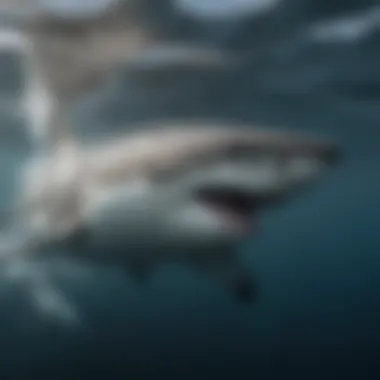
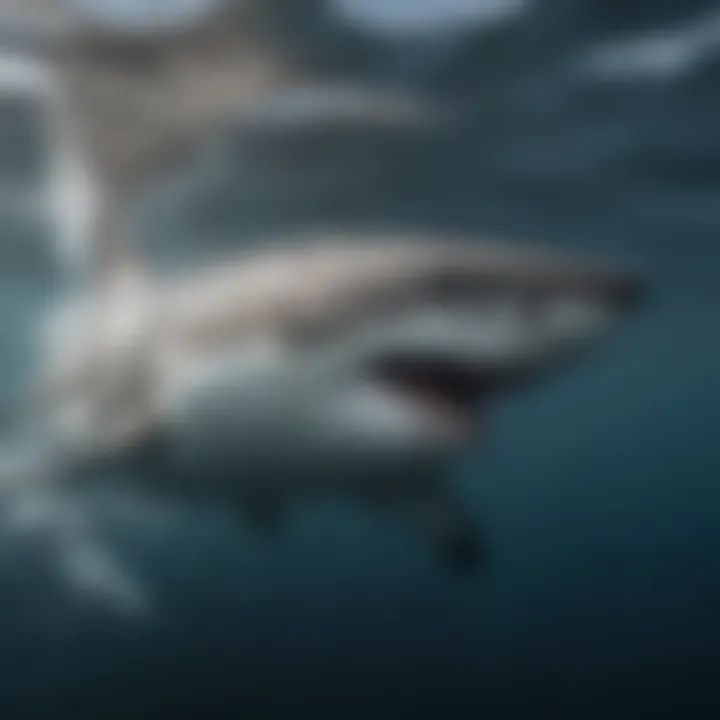
Intro
The great white shark, pivotal in the narrative of marine life, often occupies both the spotlight and the shadows of public fascination. It evokes awe, fear, and even misunderstanding, creating a complex portrait of an apex predator that dominates the oceanic realm. This article takes a deep dive into the various aspects that characterize this species, from its formidable physical characteristics to the significant ecological roles it plays in maintaining the balance of marine environments.
Often, we feel more comfortable with what we can grasp or categorize, yet the reality of the great white diverges significantly from sensationalized media portrayals. With the rampant spread of misinformation, it’s crucial to dissect the myths that surround this creature while shedding light on its biological importance and conservation need. Most enthusiasts, researchers, and admirers of marine life overlook that beyond the fierce reputation lies a fascinating study of adaptation and resilience.
As we navigate through the intricate facets of the great white shark, we will examine its unique adaptations, behaviors, interactions within ecosystems, and the urgent conservation issues it faces today. This exploration is essential not just for those who share a passion for the ocean but also for anyone looking to understand the multifarious dynamics within the marine kingdom.
In brief, this comprehensive examination aims to bridge the gap between public perception and scientific reality, illuminating the grandeur of the great white shark while advocating for its conservation.
Prelude to the Great White Shark
The great white shark often conjures images of sheer power and grace, a creature that commands respect across oceans. This apex predator holds a unique place in marine ecosystems, balancing the health of various species in the underwater food chain. Understanding the great white is not just about recognizing its fearsome reputation; it's about grasping the intricate role it plays in maintaining the ocean's delicate balance.
In this article, we aim to peel back the surface of public perception, going beyond sensationalized portrayals to explore the biological wonders and complexities of this magnificent species. The great white shark isn't merely a feared predator; it is a species shaped by millions of years of evolution, possessing physical traits and behavioral patterns that ensure its survival in a constantly changing environment.
Overview of the Species
The great white shark, scientifically known as Carcharodon carcharias, is one of the largest predatory fish found in the world's oceans. Typically reaching lengths of 15 to 20 feet and weighing up to 2,400 pounds, these sharks showcase a powerful conformation that is finely adapted to their predatory lifestyle. Their bodies are designed for speed and agility, allowing them to become formidable hunters.
Key Characteristics:
- Coloration: A striking contrast of gray on top and white underneath, serving as camouflage while hunting.
- Sensory Organs: Highly developed sense of smell and electroreception capabilities help them detect prey from great distances.
- Lifespan: While the average lifespan varies, many experts believe they can live up to 70 years or more in the wild, contributing to their slow reproductive rate.
Such characteristics emphasize the great white as a species of considerable interest not only to marine biologists but also to conservationists and enthusiasts alike.
Historical Context
The history of the great white shark reveals an evolutionary tale that stretches back over 400 million years, making them older than dinosaurs. Fossils suggest that the ancestors of the great white appeared during the early Miocene epoch, evolving in response to changing ocean ecosystems. Their physiological traits, such as a powerful jaw filled with serrated teeth, have been shaped through natural selection, allowing them to thrive in various marine habitats.
The cultural narrative surrounding great whites has also evolved dramatically.
Historical Points:
- Nautical Folklore: Throughout history, sailors and coastal communities have spun tales of massive sea monsters, often drawing inspiration from encounters with great whites.
- Scientific Interest: In the mid-20th century, researchers began studying this species intensely, leading to vital discoveries regarding their migration patterns and social structures.
Today, the great white shark is a subject of extensive research, with their numbers and habitats monitored closely to ensure the species' survival amid environmental change and human threats. From historical fear to newfound curiosity, the trajectory of public understanding illustrates how complex this species truly is.
Physical Characteristics
The physical characteristics of the great white shark are crucial not only for understanding its biological advantages but also for illuminating its role within marine ecosystems. These characteristics are more than just superficial features; they provide insight into the shark's hunting strategies, survival tactics, and interaction with the environment. By examining these attributes, one can appreciate how the great white has adapted over millions of years to become one of the ocean’s most formidable predators. Understanding its anatomy and adaptive traits can also shed light on the conservation challenges it currently faces.
Size and Weight Dynamics
The size and weight of the great white shark are nothing short of impressive. Mature individuals typically weigh between 1,500 to 2,400 pounds, and they can reach lengths of up to 20 feet or even more in some cases. This substantial size is a double-edged sword; it allows the shark to dominate as an apex predator but also makes it vulnerable to certain environmental changes, such as fluctuations in prey availability. The sheer mass of these creatures contributes to their capability to exert a significant influence over their ecosystems, controlling the population dynamics of their prey species.
Key Points:
- Maturity and size affect reproductive rates. Larger females are known to produce more offspring.
- The weight of a great white can fluctuate due to seasonal feeding patterns and breeding activities.
Anatomy and Adaptations
The anatomy of the great white shark is finely tuned for efficiency in its oceanic environment. Each part of its body plays a specific role, enhancing its ability to hunt, navigate, and thrive in an aquatic habitat.
Skin and Coloration
The great white's skin is both tough and adaptive. It has a unique structure made up of dermal denticles that reduce drag in the water, allowing for swift movements. The coloration, a combination of gray on the top and white on the belly, serves a critical role in camouflage. This countershading helps this shark blend into the ocean depths when seen from above as well as from below, allowing it to ambush unsuspecting prey.
Key Characteristics:
- The skin is tough yet flexible, contributing to its agility.
- Coloration aids in hunting and avoiding detection by both prey and potential threats.
This combination of characteristics makes the skin and coloration an essential topic in understanding the great white shark's hunting prowess and survival skills.
Fins and Their Functions
Fins play a vital role in the anatomy of the great white shark. They not only assist with swimming but also help with steering and balance in the water. The pectoral fins, for instance, provide lift and help the shark maintain stability while swimming at different depths. The large dorsal fin is not only a stabilizer but also serves as a visual indicator of the shark’s presence in the water.
Key Characteristics:
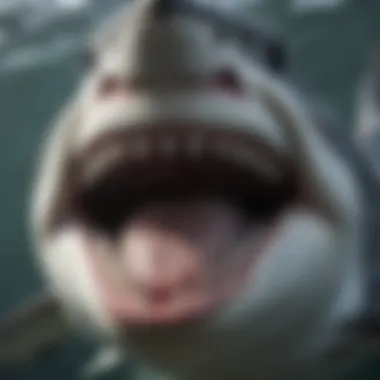
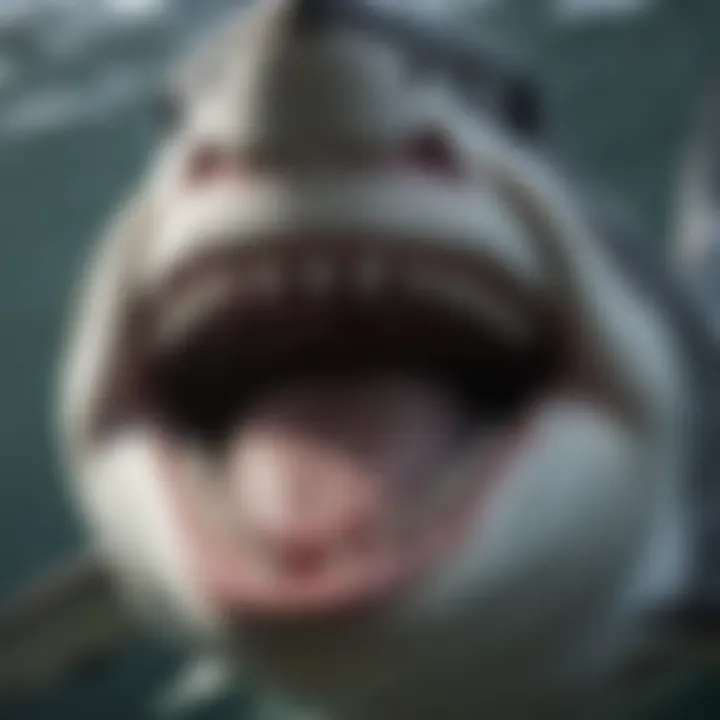
- Dorsal fins act as stabilizers, while the pectoral fins manage buoyancy.
- The structure enhances maneuverability while hunting, allowing for quick changes in direction.
Examining these functions helps explain how adaptation in fins has been essential for the great white shark as both a predator and survivor.
Teeth Structure
The teeth of the great white shark resemble a row of sharp daggers, specifically designed to ensure that once prey is bitten, it doesn't escape easily. The great white has several rows of teeth, enabling it to continuously replace those that wear down or break. This characteristic ensures that it maintains its efficiency as a predator over time.
Key Characteristics:
- Teeth are triangular, serrated, and adapted for cutting through flesh.
- Continuous replacement allows the shark to always have effective hunting tools.
Understanding the structure of great white teeth is crucial in not only recognizing their role in predation but also in learning more about the creature's evolutionary adaptations.
In summary, the physical characteristics of the great white shark play a significant role in its ecology and survival. From size and weight dynamics to the intricate details of its anatomy, each element provides insight into this impressive species while revealing its vulnerabilities in a changing world.
Behavioral Patterns
Understanding the behavioral patterns of the great white shark is crucial for several reasons. First, it sheds light on their hunting techniques, social structures, and migratory habits, which are all integral to their survival. By studying these patterns, researchers can appreciate how these predators interact with their environment. This section delves into the hunting strategies they deploy, their social behavior, and the extraordinary ways they navigate the ocean.
Hunting Techniques
Hunting is not just about raw power; it’s about strategy and finesse. Great white sharks showcase a range of hunting techniques that highlight their adaptability to different situations.
Prey Selection
Prey selection is fundamental for great whites, impacting their overall success as predators. They often favor larger marine life such as seals, sea lions, and even small whale species. The recognition of these preferred prey allows them to optimize their feeding efficiency. A key characteristic of their prey selection is their ability to target animals that are weaker or injured. This tactic increases the chances of successful hunts and reduces energy expenditure, which is essential for these apex predators. The unique feature here is the shark's acute sense of smell; they can detect a drop of blood in the ocean from miles away. While this predilection can be viewed as an advantage, it can also pose a risk during the hunting process, as an overreliance on specific prey may expose them to competition and food scarcity.
Ambush Strategies
Ambush strategies are a hallmark of the great white's hunting style. They utilize stealth and patience—often lying in wait near seal colonies, concealed by the ocean’s depths. The essential aspect of this tactic involves the element of surprise. By accelerating from the depths, they can launch an explosive attack on unsuspecting prey. This strategy not only ensures a higher success rate but also conserves energy. The unique feature of this approach is their ability to swim vertically—a remarkable trait that allows them to strike with astonishing force. However, while ambush techniques are often effective, they depend on environmental factors, such as water clarity and prey behavior, which can fluctuate seasonally.
Social Interactions
Social behavior in great white sharks can puzzle many enthusiasts. They are not completely solitary creatures as commonly believed. Research indicates that some individuals engage in social interactions, particularly in hunting groups. This behavior enhances their chances of capturing larger prey and demonstrates adaptability. Unlike other shark species, great whites may occasionally exhibit playful behavior among themselves, leading to a better understanding of their social dynamics and hierarchies.
Migration and Movement
Migration is a vital aspect of their existence, influenced by varied factors such as prey availability and breeding cycles. Their movement patterns reveal much about how interconnected marine ecosystems are and highlight the importance of conserving migratory routes.
Navigation Patterns
The navigation patterns of great white sharks are a testament to their remarkable instincts. Utilizing a combination of sensory perception—including electromagnetic fields and celestial navigation—these sharks can travel thousands of miles between feeding grounds and breeding areas. A standout characteristic is their ability to remember locations based on previous experiences, making their movements appear almost purposeful. Understanding these navigation patterns is instrumental in predicting their behavior and can inform conservation measures to protect essential habitats.
Seasonal Changes
Seasonal changes drive significant shifts in the behavior of great white sharks. As water temperatures fluctuate, these sharks often migrate to find optimal hunting conditions. For instance, during warmer months, they move closer to coastal areas rich in prey, while in colder months, they tend to venture to deeper waters. This adaptability to seasonal changes ensures they capitalize on available resources throughout the year. However, these migrations can also expose them to greater human activity, emphasizing the need for vigilant conservation efforts.
"The life of a great white shark is a delicate balance of survival, instinct, and adaptation to ever-changing oceanic environments."
By closely examining these various aspects of great white shark behavioral patterns, we gain insights into the intricacies of marine ecosystems and the importance of this apex predator. This knowledge not only adds to our understanding of these magnificent creatures but also underscores the urgency of conservation efforts.
Ecological Role
The ecological role of the great white shark is a cornerstone to understanding marine ecosystems. As apex predators, they sit at the top of the food chain, influencing not just their prey, but the entire underwater community. Their presence is essential for maintaining the balance of species within coastal waters. This section unpacks the dynamics that showcase the significance of the great white shark in its natural habitat.
Apex Predator Status
The status of the great white shark as an apex predator speaks volumes about its ecological importance. Being at the top of the food web enables them to regulate populations of marine species, particularly seals and other marine mammals. This regulation helps ensure that no single species dominates the ecosystem, allowing multiple species to thrive.
"Apex predators create a richness in the ecosystem that promotes health and diversity."
This balance fosters a robust biodiversity, essential for the resilience of marine environments. When great whites are removed from these ecosystems, a phenomenon called trophic cascade can occur, causing significant shifts in population dynamics of prey species.
Impact on Marine Ecosystems
The impact of great white sharks extends beyond their direct predation; they play a crucial role in sustaining the ecosystem's health.
Population Control
Population control is a significant aspect of the ecological role of the great white shark. Their hunting habits help to manage the populations of various fish and marine mammals, preventing overpopulation which could lead to habitat degradation. Without this natural control, species such as seals could proliferate uncontrollably, leading to scarcity of available resources for other marine life.
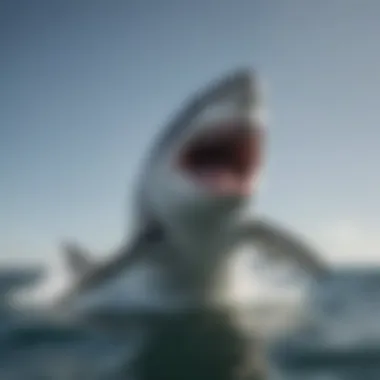
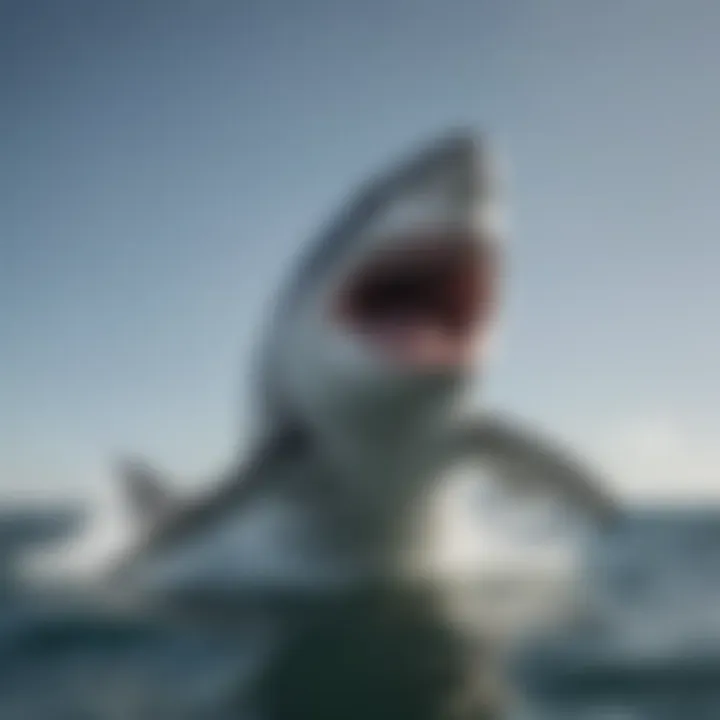
Moreover, the characteristic hunting method of great white sharks—selective predation—ensures that only the weak or sick individuals of prey populations are targeted. This natural selection keeps the populations healthier overall, as it allows for the survival of the fittest, promoting genetic strength within those species.
Species Diversity
The contribution of great white sharks to species diversity is another interesting facet of their ecological role. Their predation habits encourage a more diverse range of species to inhabit a given area. When certain species are taken out of the equation, it creates opportunities for others to thrive, thus enhancing the diversity of life forms.
The unique feature of the great white as a marine predator is its habit of patrolling vast areas, which allows for the mixing of different populations. This behavior contributes to genetic diversity among fish populations. Fish species that are genetically diverse are often more resilient to diseases and environmental changes.
In summary, the great white shark plays a pivotal role in regulating populations and promoting the diversity of marine life. This ecological balance is critical; without it, these environments could face serious declines in population health and species richness.
Conservation Challenges
Understanding the conservation challenges faced by the great white shark is critical for appreciating its role in the ocean ecosystem. This apex predator is not just a remarkable creature to marvel at; it’s integral to the health of marine life. When these sharks struggle, the entire ecological balance can be thrown off kilter. It's important to recognize the threats they face, as well as the efforts being made to protect them.
Threats to the Species
Commercial Fishing
Commercial fishing has a significant impact on the population of great white sharks. These sharks unintentionally get caught in fishing nets and on hooks, leading to severe population declines. A notable issue is the practice of finning, where sharks have their fins removed for shark fin soup, leaving them to die. This not only decreases the numbers of great whites but also disrupts natural order in coastal domains where they exert control over prey populations.
The key characteristic of commercial fishing here is its scale. Fisheries operate on a massive level, targeting various species, often without considering the bycatch, which includes sharks. This method of fishing appears to be efficient, making it a popular choice for suppliers eager to meet demand. Unfortunately, it is a double-edged sword since the unchecked hunting of these animals ultimately poses risks to marine biodiversity.
The unique feature is how this practice has become deeply entwined with cultural cuisines, especially in some Asian countries where demand for shark fin has driven fleets to seek these sharks aggressively. The advantage for the industry is clear profit, but for the sharks, it means a precarious future.
Habitat Degradation
Habitat degradation has emerged as another substantial concern for the great white shark. This includes factors like pollution, coastal development, and climate change which degrade the environments vital to their life cycles. The coastal waters, where these sharks often hunt for seals and other prey, are affected by rising temperatures and ocean acidification.
This degradation greatly impacts the breeding grounds needed for reproduction and sustenance, making healthy habitats essential for their conservation. It’s a sobering thought that while coastal resorts and urban sites flourish, the natural settings necessary for wildlife, including our sharks, are undergoing detrimental changes.
The unique feature of habitat change is how quickly it can erode the environments that these species rely on, leaving no room for recovery. Although such developments may bring economic benefits to human populations, the disadvantage is the loss of critical marine biodiversity, including declines in shark populations.
Conservation Efforts
With increasing awareness of the importance of sharks to ocean ecosystems, conservation efforts have gained traction. Addressing these challenges head-on is paramount for the future of the great white shark.
Protected Areas
Protected areas have been implemented in various locations around the world to help safeguard the habitats of great white sharks. These regions limit human activities that can harm marine life, such as fishing and tourism, establishing safe havens for these majestic creatures.
The main characteristic of protected areas is their regulatory framework designed to preserve biodiversity. They provide a direct benefit by reducing human pressure on shark populations and their habitats, allowing for easier recovery. For the great whites, this means that individuals can thrive in regions that are free from overfishing and habitat destruction.
However, while these protections can be highly beneficial, they are not a panacea. The drawback to such measures is that enforcement can be challenging, especially in regions with prevalent illegal fishing activities.
Research Initiatives
Research initiatives play a vital role in the conservation of great white sharks. Studies focused on their behavior, populations, and habitats provide critical data that can shape preservation strategies. For instance, satellite tracking and tagging have unveiled insights into their migration patterns, which in turn informs conservationists about essential habitats requiring protection.
The highlighted aspect of research initiatives is their evidence-based approach. They provide a substantial advantage by grounding conservation actions in scientific facts, allowing for targeted measures that yield effective results. This informed decision-making can elevate the efforts of wildlife conservation groups and governments alike.
Yet, the challenge remains that research often requires considerable funding and long-term commitments, which can be scarce. The unique feature of these initiatives is that they are ever-evolving, adapting as new technologies and information emerge.
In sum, protecting the great white shark isn’t just crucial for its survival; it’s essential for maintaining the health of our oceans. By facing the threats head-on and bolstering conservation efforts, there lies hope for the future of this iconic species.
"Conservation measures must evolve as our understanding of species like the great white shark deepens, ensuring they have a fighting chance in our increasingly industrialized world."
In light of these challenges and efforts, it becomes clear: the fate of the great white shark is deeply woven into the broader tapestry of marine health. Engaging with these topics not only enhances awareness but also sparks action among those who surf, paddleboard, and kite surf. It’s a call to safeguard our oceans for generations to come.
Myths and Misconceptions
Myths and misconceptions often surround the great white shark, shrouding its true nature in a cloud of misunderstanding. These narratives, be they sensationalized stories from films or misinformed beliefs passed down through generations, can lead to fear and misguided perceptions of this magnificent creature. It’s imperative to address these misconceptions not just to foster a more accurate understanding of the great white but also to support its conservation and management efforts. By unpacking these myths, enthusiasts can have a clearer view of these apex predators and their crucial role in oceanic systems.
Cultural Representation
Cultural representation plays a significant role in shaping our understanding of the great white shark. Movies like "Jaws" have set a lasting impression, portraying this species as mindless killers lurking beneath the waves. This image sticks like glue, making it challenging for everyday folks to reconcile the truth of the shark's behavior with what they see on screen. While it’s true that great whites are skilled hunters, reducing them to mere villains overlooks their ecological significance and intelligent nature.
Furthermore, literature and media often depict them as threats rather than animals that exhibit complex behaviors and social structures.
- Media Influence:
- Movies and documentaries often feature dramatic encounters.
- News reports tend to sensationalize shark attacks, exaggerating their frequency and severity.
This skewed representation leads to unnecessary fear, which can impact the species negatively, influencing public policy and attitudes toward conservation.

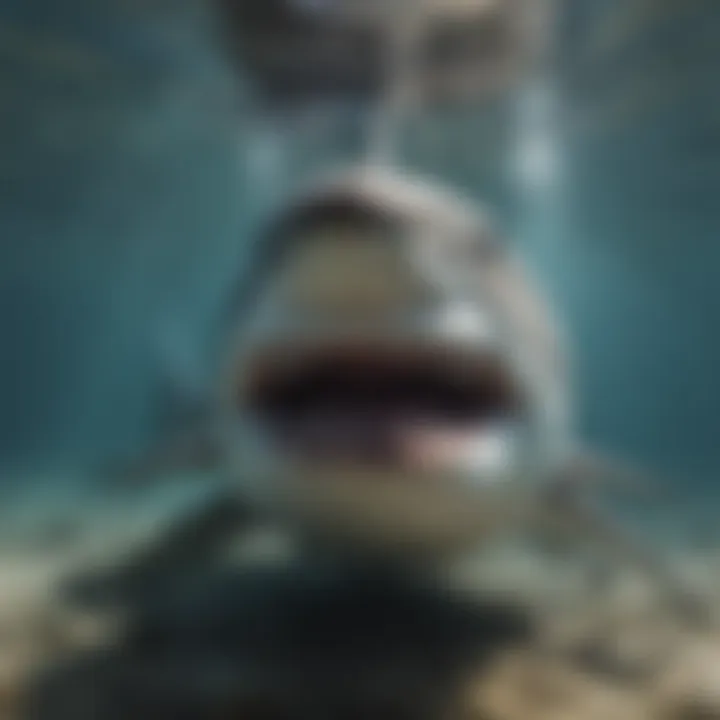
Addressing Fear and Misunderstanding
Addressing the fear and misunderstanding surrounding great white sharks is paramount for their conservation. While it's natural to feel apprehensive about such a powerful predator, it’s beneficial to examine the realities. Shark attacks, while startling, are exceedingly rare. In fact, according to the International Shark Attack File, the odds of encountering a shark in a dangerous situation are less than one in 11 million.
Education serves as a critical tool here. By sharing factual information about the behavior and ecology of great white sharks, experts can demystify the fear surrounding them.
- Key Points to Consider:
- Most interactions with humans are cases of curiosity rather than aggression.
- Sharks play an essential role in maintaining balanced ecosystems.
As highlighted in various studies, the more we learn about these creatures, the more we understand their value and the importance of protecting them. > "Fostering respect for great whites enhances conservation efforts, ensuring a balanced ocean environment for future generations."
Through educational efforts, we can shift from a mindset rooted in fear to one of respect and awe, ultimately benefiting both the great white shark and the marine ecosystems in which it thrives.
Documentary and Research Contributions
Documentaries and research initiatives play a pivotal role in shaping our understanding of great white sharks. They act as windows into the often unseen behaviors, habitats, and challenges these magnificent creatures face. This section explores the profound contributions of documentaries and studies about the great white shark, shedding light on specific elements, benefits, and the ongoing impact of these visual and scholarly endeavors.
Major Studies and Findings
In recent years, significant studies have deepened our comprehension of great white sharks’ behaviors and ecological roles.
- Population Monitoring Studies: Research conducted off the coasts of California and Australia has tracked migratory patterns and breeding habits. These studies reveal fluctuations in population numbers and highlight the connection between environmental factors and shark health. For instance, a study from the University of California found that warmer waters could lead to increased shark sightings due to altered prey availability.
- Tagging and Tracking: Technologies like acoustic tagging have allowed researchers to follow sharks’ movements in real-time. These tracking efforts demonstrate their extensive migrations, oftentimes covering thousands of kilometers. Findings from the Pelagics Collaborative indicated that these sharks often return to the same feeding grounds year after year, demonstrating strong site fidelity.
- Behavioral Research: A notable study published in Marine Biology focused on the hunting techniques of great whites, revealing striking insights into how they employ strategic ambush tactics. Researchers observed variations in hunting styles based on prey availability, showcasing their adaptability and intelligence.
Such studies not only enhance our ecological knowledge but also underscore the importance of ongoing research in conservation efforts. Understanding the nuances of their behavior and habitat needs helps inform strategies to ensure their survival.
"Documentary work often serves as a bridge between the scientists and the public, making complex research accessible and engaging."
Media Influence
The role of media in shaping perceptions about great white sharks cannot be understated. Documentaries, in particular, serve as compelling narratives that capture the imagination of viewers worldwide. These visual stories often highlight the splendid beauty and crucial ecological roles of sharks while tackling misconceptions.
- Representation in Documentaries: Productions like Sharkwater and Chasing Sharks have played critical roles in raising awareness about the plight of sharks amidst growing conservation challenges. They reflect a shift towards advocating for the protection of these apex predators rather than perpetuating fear-based narratives.
- Social Media Impact: Platforms like Facebook and Reddit have transformed how information about great whites is shared and consumed. By posting personal experiences, like sightings during surfing or paddleboarding, enthusiasts resonate with a broader audience. Users can comment, question, and engage with scientists directly, fostering a community of awareness and action.
- Education and Awareness Campaigns: Effective use of media goes beyond sensationalism; it cultivates educational campaigns designed to shift public perceptions. Initiatives that emphasize the ecological significance of great whites contribute significantly to changing the narrative from one of fear to appreciation and respect.
Documentary storytelling and research findings combined foster a more nuanced understanding of great white sharks. As scientists and filmmakers collaborate, there is hope for more informed public perception and a united front in conservation efforts. Understanding this creates a dialogue that benefits not just sharks, but the entire marine ecosystem they sustain.
Human Interaction
Human interaction with great white sharks encompasses a range of complex dynamics that can significantly impact both the species and the people who share their environment. Understanding this relationship is crucial, not just for the conservation of these magnificent animals, but also for enhancing the safety and enjoyment of activities in the ocean, particularly for the surfing, paddleboarding, and kitesurfing communities. Learning to live harmoniously with these apex predators can help mitigate fears and promote a deeper appreciation of the ocean's ecosystem.
Shark Attacks: Reality vs. Perception
When discussing great white sharks, perhaps the most sensational aspect is the idea of shark attacks. But reality often runs contrary to popular belief. The perception of these creatures as mindless killers is not only inaccurate but absurdly misleading. Statistics reveal that the likelihood of being attacked by a shark is exceedingly small. For example, in the entire year of 2020, there were relatively few reported unprovoked attacks worldwide. This underscores how exceedingly rare serious incidents are.
Moreover, differentiating between actual attacks and encounters can further dispel misconceptions. Most interactions are non-aggressive and often attributed to curiosity rather than predation. A great white might investigate a person on a surfboard, mistaking them for a seal. This leads to glancing bites or nudges rather than intent to harm.
Education plays a pivotal role here. Surfers and other ocean enthusiasts can benefit from understanding these behaviors and recognizing safe practices while in waters populated by sharks. Common sense precautions like avoiding swimming at dusk or dawn, staying in groups, and refraining from excessive splashing might mitigate risks while fostering a respectful coexistence.
"The ocean is an intricate web of life; understanding our place within it can yield mutual benefits for both humans and sharks."
Ecotourism and Conservation
Ecotourism has emerged as a powerful tool for conservation efforts related to great white sharks. By creating an economic incentive for preserving marine ecosystems, ecotourism encourages local communities to protect these animals rather than fear them. Programs that promote shark diving and educational tours help foster a positive perception of sharks, steering narratives away from fear and toward fascination.
Not only does ecotourism raise awareness about the ecological roles of great whites, but it also generates funds that can be used to support conservation projects. For example, revenue from ecotourism ventures can go toward research that improves our understanding of great white shark behaviors, migration patterns, and habitat needs. This creates a cycle where the interests of the community align with the conservation of the species.
Some key benefits of a focus on ecotourism in relation to great whites include:
- Increased funding for marine research and protection initiatives
- Promotion of sustainable practices within local fishing industries
- Public education about marine life and its importance in the ecosystem
- Enhancement of local economies through tourism
Learn more about sharks and conservation efforts on Wikipedia
Ecotourism benefits in marine conservation
Engage in discussions about marine life on Reddit
Share your experiences on Facebook
Summary and Future Directions
The significance of summarizing the extensive knowledge acquired on the great white shark and exploring future directions in research and conservation cannot be understated. As we close the discussion on this remarkable species, it’s vital to reflect on what we have learned and how these insights can shape the future. Understanding the intricate relationships these sharks hold with marine ecosystems not only enhances our appreciation but also informs effective conservation strategies. By addressing their ecological roles, behavioral patterns, and the pressing challenges they face, we pave the way for a more sustainable coexistence between humans and these magnificent creatures.
Key Takeaways
- Ecological Importance: The great white shark plays a vital role as an apex predator, maintaining the balance within marine ecosystems by regulating prey populations and contributing to species diversity. This highlights the need for ongoing research to fully understand their impact on the environment.
- Conservation Challenges: Various threats, such as overfishing and habitat degradation, place the great white shark at risk. Recognizing these threats enables the formulation of targeted conservation measures to protect their populations and habitats.
- Public Perception: Myths and misconceptions about great white sharks can skew public opinion and hinder conservation efforts. Education is essential, promoting a more balanced understanding of these sharks’ behaviors, which can demystify them and foster appreciation rather than fear.
- Research Gaps: There are still many areas where knowledge is lacking. Key research areas include the specifics of their migratory patterns and the long-term impact of environmental changes on their populations.
"Understanding the behavior and ecology of great white sharks is crucial for our efforts to conserve them and the marine ecosystem they inhabit."
Next Steps in Research and Conservation
- Implementing Research Initiatives: Future research should prioritize gathering data on great white shark populations, their migratory and breeding habits, and their responses to changing oceanic conditions. Tagging and tracking studies can yield invaluable information that helps understand their movement patterns and habitat preferences.
- Strengthening Conservation Policies: There's a need for more stringent regulations regarding fishing practices that affect great white sharks. Advocating for the creation and enforcement of protected marine areas will be vital in providing safe havens for these sharks.
- Public Awareness Campaigns: Increasing public awareness about the role of great white sharks in the ecosystem can help alleviate fears and change perceptions. Initiatives to engage communities through educational programs, documentaries, and ecotourism can foster a sense of responsibility towards marine conservation.
- Collaboration Across Sectors: Partnerships between researchers, conservation organizations, and the fishing industry can create a more holistic approach to shark conservation. Combining efforts can ensure all voices are heard and integrated into action plans, ultimately benefitting the health of our oceans.
- Monitoring Climate Change Impacts: As climate change continues to alter marine environments, monitoring its impact on shark behavior and distribution will be essential. This involves adapting conservation strategies accordingly to mitigate any adverse effects on great white shark populations.
By focusing on these key areas, we can ensure that our understanding and conservation of the great white shark evolves, allowing future generations to appreciate and witness the splendor of these apex predators in their natural habitats.



